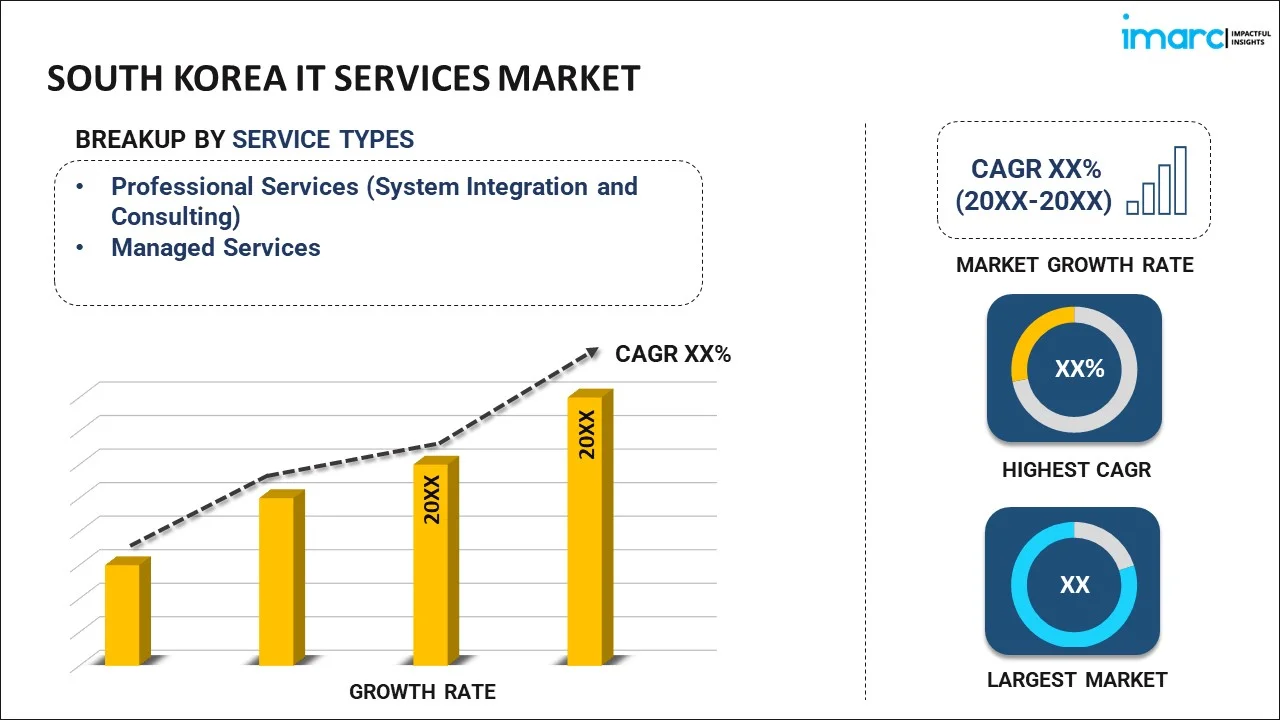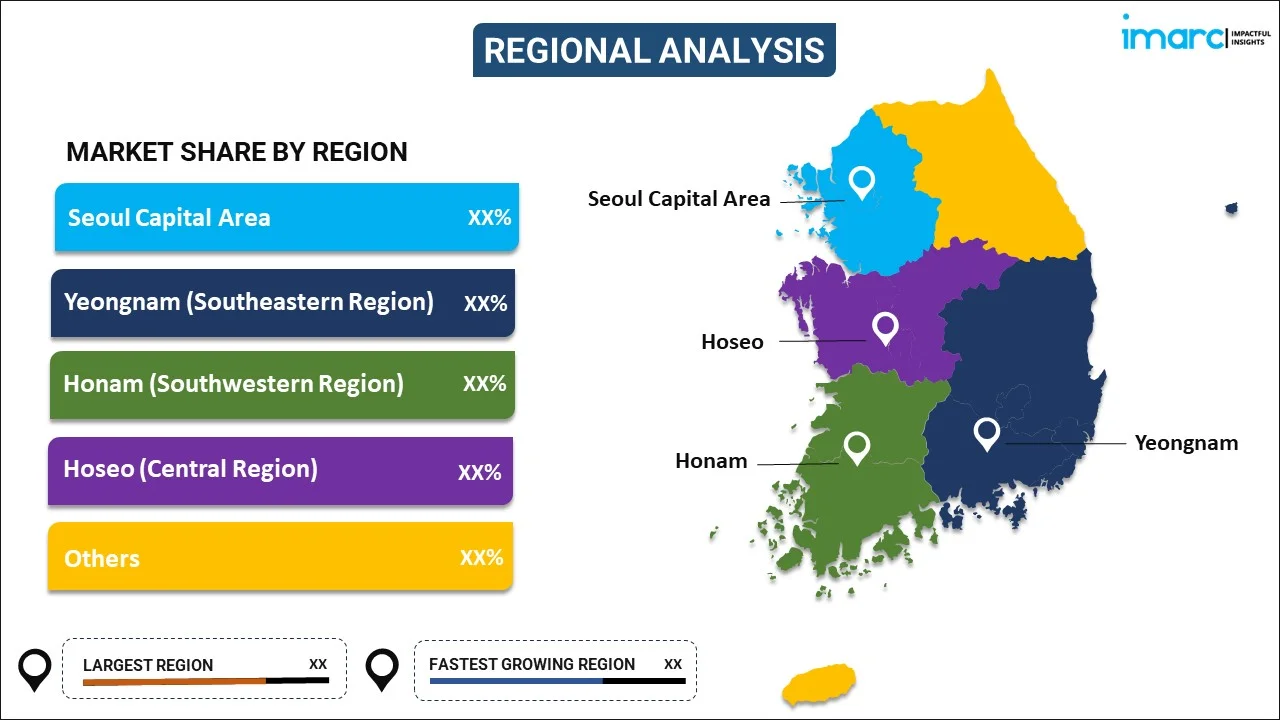
South Korea IT Services Market Report by Service Type (Professional Services (System Integration and Consulting), Managed Services), Enterprise Size (Small and Medium-sized Enterprises, Large Enterprises), Deployment Mode (On-premises, Cloud-based), End Use Industry (BFSI, Telecommunication, Healthcare, Retail, Manufacturing, Government, and Others), and Region 2025-2033
Market Overview:
South Korea IT services market size reached USD 23.2 Billion in 2024. Looking forward, IMARC Group expects the market to reach USD 43.9 Billion by 2033, exhibiting a growth rate (CAGR) of 6.6% during 2025-2033. The widespread adoption of remote working module, rising utilization of advanced technologies like cloud computing, artificial intelligence (AI), and data analytics, and the increasing reliance on e-commerce platforms represent some of the key factors driving the market.
|
Report Attribute
|
Key Statistics
|
|---|---|
|
Base Year
|
2024
|
|
Forecast Years
|
2025-2033
|
|
Historical Years
|
2019-2024
|
| Market Size in 2024 | USD 23.2 Billion |
| Market Forecast in 2033 | USD 43.9 Billion |
| Market Growth Rate 2025-2033 | 6.6% |
Information technology (IT) services encompass a wide range of activities and solutions that aid in managing, maintaining, and leveraging technology infrastructure to support businesses and organizations. They often include 24/7 monitoring to detect and address issues promptly, thereby ensuring minimal downtime. They rely on skilled professionals who possess in-depth knowledge of various technologies, software, and hardware components. They can be tailored to meet the specific needs and size of an organization, allowing for flexibility in service delivery. They streamline operations, automate tasks, and optimize processes, leading to increased productivity. They ensure that systems are available and functioning correctly, minimizing disruptions and downtime. They facilitate ongoing technical support, troubleshooting, and maintenance for hardware and software. They help protect systems and data from cyber threats through services like antivirus, firewalls, and intrusion detection. They also assist in managing and securing data, including backup, storage, and data recovery services. Besides this, as they aid in creating customized software solutions to address specific business needs, the demand for IT services is increasing in South Korea.
South Korea IT Services Market Trends:
There is a rise in digitalization of businesses and an increase cyber threats across South Korea. As a result, several organizations are investing in cybersecurity services to protect their sensitive data and networks. This, coupled with the rising adoption of remote work and collaboration tools, represents one of the key factors strengthening the growth of the market in the country. Apart from this, the increasing adoption of advanced technologies like cloud computing, artificial intelligence (AI), and data analytics to enhance efficiency, customer experiences, and decision-making are facilitating the growth of the market. In line with this, the escalating demand for IT services that can help companies navigate this digital transition effectively is offering a favorable market outlook. Furthermore, governing agencies of the country are actively supporting the growth of the IT sector. They are consequently undertaking several initiatives, such as the "Korea New Deal" and "Digital New Deal," and allocating significant funds to increase digital infrastructure and innovation. Moreover, the widespread availability of 5G networks is creating lucrative opportunities for IT service providers to offer high-speed connectivity solutions, enabling businesses to leverage the capabilities of this next-generation technology. In line with this, the increasing reliance of individuals in South Korea on e-commerce platforms is offering a favorable market outlook. IT services enable e-commerce companies to manage their platforms efficiently, handle transactions securely, and offer personalized shopping experiences.
South Korea IT Services Market Segmentation:
IMARC Group provides an analysis of the key trends in each segment of the market, along with forecasts at the country level for 2025-2033. Our report has categorized the market based on service type, enterprise size, deployment mode, and end use industry.
Service Type Insights:

- Professional Services (System Integration and Consulting)
- Managed Services
The report has provided a detailed breakup and analysis of the market based on the service type. This includes professional services (system integration and consulting) and managed services.
Enterprise Size Insights:
- Small and Medium-sized Enterprises
- Large Enterprises
A detailed breakup and analysis of the market based on the enterprise size have also been provided in the report. This includes small and medium-sized enterprises and large enterprises.
Deployment Mode Insights:
- On-premises
- Cloud-based
The report has provided a detailed breakup and analysis of the market based on the deployment mode. This includes on-premises and cloud-based.
End Use Industry Insights:
- BFSI
- Telecommunication
- Healthcare
- Retail
- Manufacturing
- Government
- Others
A detailed breakup and analysis of the market based on the end use industry have also been provided in the report. This includes BFSI, telecommunication, healthcare, retail, manufacturing, government, and others.
Regional Insights:

- Seoul Capital Area
- Yeongnam (Southeastern Region)
- Honam (Southwestern Region)
- Hoseo (Central Region)
- Others
The report has also provided a comprehensive analysis of all the major regional markets, which include Seoul Capital Area, Yeongnam (Southeastern Region), Honam (Southwestern Region), Hoseo (Central Region), and Others.
Competitive Landscape:
The market research report has also provided a comprehensive analysis of the competitive landscape. Competitive analysis such as market structure, key player positioning, top winning strategies, competitive dashboard, and company evaluation quadrant has been covered in the report. Also, detailed profiles of all major companies have been provided.
South Korea IT Services Market Report Coverage:
| Report Features | Details |
|---|---|
| Base Year of the Analysis | 2024 |
| Historical Period | 2019-2024 |
| Forecast Period | 2025-2033 |
| Units | Billion USD |
| Scope of the Report | Exploration of Historical Trends and Market Outlook, Industry Catalysts and Challenges, Segment-Wise Historical and Future Market Assessment:
|
| Service Types Covered | Professional Services (System Integration and Consulting), Managed Services |
| Enterprise Sizes Covered | Small and Medium-sized Enterprises, Large Enterprises |
| Deployment Modes Covered | On-premises, Cloud-based |
| End Use Industries Covered | BFSI, Telecommunication, Healthcare, Retail, Manufacturing, Government, Others |
| Regions Covered | Seoul Capital Area, Yeongnam (Southeastern Region), Honam (Southwestern Region), Hoseo (Central Region), Others |
| Customization Scope | 10% Free Customization |
| Post-Sale Analyst Support | 10-12 Weeks |
| Delivery Format | PDF and Excel through Email (We can also provide the editable version of the report in PPT/Word format on special request) |
Key Questions Answered in This Report:
- How has the South Korea IT services market performed so far and how will it perform in the coming years?
- What has been the impact of COVID-19 on the South Korea IT services market?
- What is the breakup of the South Korea IT services market on the basis of service type?
- What is the breakup of the South Korea IT services market on the basis of enterprise size?
- What is the breakup of the South Korea IT services market on the basis of deployment mode?
- What is the breakup of the South Korea IT services market on the basis of end use industry?
- What are the various stages in the value chain of the South Korea IT services market?
- What are the key driving factors and challenges in the South Korea IT services?
- What is the structure of the South Korea IT services market and who are the key players?
- What is the degree of competition in the South Korea IT services market?
Key Benefits for Stakeholders:
- IMARC’s industry report offers a comprehensive quantitative analysis of various market segments, historical and current market trends, market forecasts, and dynamics of the South Korea IT services market from 2019-2033.
- The research report provides the latest information on the market drivers, challenges, and opportunities in the South Korea IT services market.
- Porter's five forces analysis assist stakeholders in assessing the impact of new entrants, competitive rivalry, supplier power, buyer power, and the threat of substitution. It helps stakeholders to analyze the level of competition within the South Korea IT services industry and its attractiveness.
- Competitive landscape allows stakeholders to understand their competitive environment and provides an insight into the current positions of key players in the market.
Need more help?
- Speak to our experienced analysts for insights on the current market scenarios.
- Include additional segments and countries to customize the report as per your requirement.
- Gain an unparalleled competitive advantage in your domain by understanding how to utilize the report and positively impacting your operations and revenue.
- For further assistance, please connect with our analysts.
 Inquire Before Buying
Inquire Before Buying
 Speak to an Analyst
Speak to an Analyst
 Request Brochure
Request Brochure
 Request Customization
Request Customization




.webp)




.webp)












